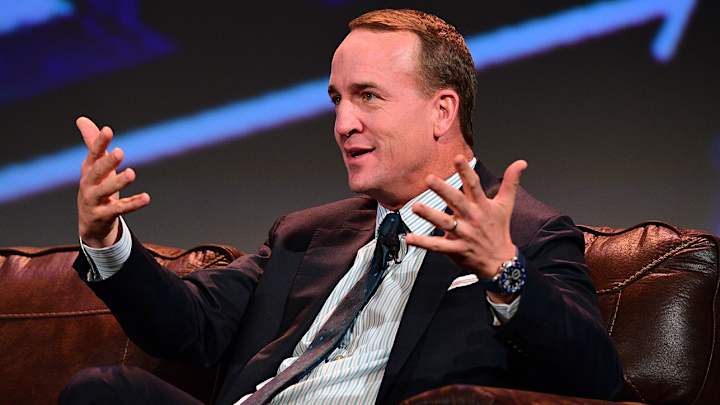With 'Peyton's Places' Show, Peyton Manning Puts a Face on Football

There’s one thing, evidently, Peyton Manning can’t do. Drive a stick shift.
He admits this during the first episode of Peyton’s Places to none other than late night host Jay Leno while sitting on an antique Hupmobile, just like NFL founders did in 1920 when they created the league.
Leno is silent. “I’m just thinking of all the times in high school,” he finally explains, “when we car guys had our girlfriends stolen by the QB. And to think he can’t even drive a stick.”
Moments later, Leno is speechless again as Manning fumbles with the clutch and gas, failing to get the car in gear. Actually I have no idea if that’s the correct terminology for Manning’s struggles, having never driven a stick myself. But that’s what makes the legend relatable (on the teen dating revisitation, obviously it’s Leno’s experience I connect with).
Everything else on the show, produced by NFL Films and available on ESPN+, Manning handles with ease. He casually plays pool with Joe Namath, strolls through the New York Stock Exchange with Jim Cramer, and completes a pass to Cris Carter off a skyscraper, natch. Somehow, he remains approachable throughout.
Rather than the operatic drama of NFL Films classics, here Manning presents the league’s history as buddy comedy. And a few extra dad jokes or Nationwide Insurance callouts aside, it’s surprisingly fun—thanks largely to its star. In addition to being sentimental about the days of Roger Staubach or Joe Montana, Peyton’s Places will make you nostalgic for Manning’s was-it-really-only-three-years-ago era.
“I don’t think anybody else could have done this show,” showrunner Neil Zender says. “It’s a shame everybody couldn’t have Peyton for their history teacher; everyone would know their history.”
Manning was deeply involved in the production from the idea phase through filming, even studying tape of his soon-to-be guest stars. His stamina on shoots amazed Zender, waking up at 5 a.m. to film with the Cubs at Wrigley, sit down with Bears owner Virginia McCaskey, interview Mike Ditka on a boat, visit Bears super fans at Soldier Field and then change his wardrobe one more time to talk to Jerome Bettis. “On a normal shoot you’d do one of those things and it’d be a full day,” Zender says. “What he doesn’t like to do is sit around.”
His genuine interest also comes across. Before and after filming, Manning could often be found wandering around the location, exploring the Packers Hall of Fame or Yankee Stadium with the quiet freedom a celebrity rarely gets. “To be able to do things like that and places like that, that’s kind of why I signed up for this opportunity,” Manning told Chris Mortensen.
Going in, you should know the show will stay positive, given its creators. “We’d like to remind people of all the things there are to love about football,” Zender says. Which again makes Manning the perfect conduit, because, as he said at his retirement press conference, “I revere football.”
And the game loves him back. After spending years as the league’s most popular player— possibly contributing to its ratings slump once he left—Manning has already transitioned into being the country’s most-loved sports media personality. When he’s done hamming it up for this mainstream offering, Manning will return to the film room for another season of Detail, providing tape geekery in the same folksy accent, which needs no description because you could easily read this sentence in his voice.
“He is,” Will Leitch wrote last week, “what the league wants to sell itself as: marketable, self-effacing-yet-dominant, all things to all people and, most of all, squeaky-clean.” Watching Peyton’s Places, you can understand why ESPN was willing to risk coming off as a spurned lover in their pursuit of Manning for the Monday Night Football booth. You might even go overboard yourself. Peyton Manning for Commissioner?! Why not? Peyton Manning for President!?!?!
But then it becomes clear why Manning has been shy to jump back into the spotlight. At times, his show comes off naive. Like when he asks Carter what position the wide receiver would’ve played in the 1920s given the lack of opportunity for pass-catchers—never minding that the NFL wouldn’t integrate for decades. He later pivots a conversation about how the NFL Draft evoked the communist manifesto to make a quip about Burt Reynolds’s The Longest Yard. With 26 episodes to go, it remains to be seen how the show will discuss recent controversies, if at all.
Manning’s own history would look different under today’s light. Having developed a knack for preternaturally sensing oncoming pressure, it certainly feels like Peyton got out at just the right time. Manning has been lucky to dodge this era. The NFL meanwhile misses him, for all the reasons Places makes plain.
Manning has carefully picked his post-career targets. A character in commercials and a disembodied drawl on Detail, his true persona has remained elusive enough. It’s one last reason why he’s the perfect fit for this show. As a constant traveler, Manning plays a player out of time, an ageless counterpart to stars through the ages. He’s football personified, but just the good parts.

Jacob Feldman is a staff writer for Sports Illustrated. He primarily covers the intersection of sports, media and the Internet.